Gigabyte Z77-HD4 Review
by Ian Cutress on May 19, 2013 10:00 AM EST- Posted in
- Motherboards
- Gigabyte
- Z77
Rightmark Audio Analyzer 6.2.5
In part due to reader requests, we are pleased to include Rightmark Audio Analyzer results in our benchmark suite. The premise behind Rightmark:AA is to test the input and output of the audio system to determine noise levels, range, harmonic distortion, stereo crosstalk and so forth. Rightmark:AA should indicate how well the sound system is built and isolated from electrical interference (either internally or externally). For this test we connect the Line Out to the Line In using a short six inch 3.5mm to 3.5mm high-quality jack, turn the OS volume to 100%, and run the Rightmark default test suite at 48 kHz, 96 kHz and 192 kHz. We look specifically at the Dynamic Range of the audio codec used on board, as well as the Total Harmonic Distortion + Noise.
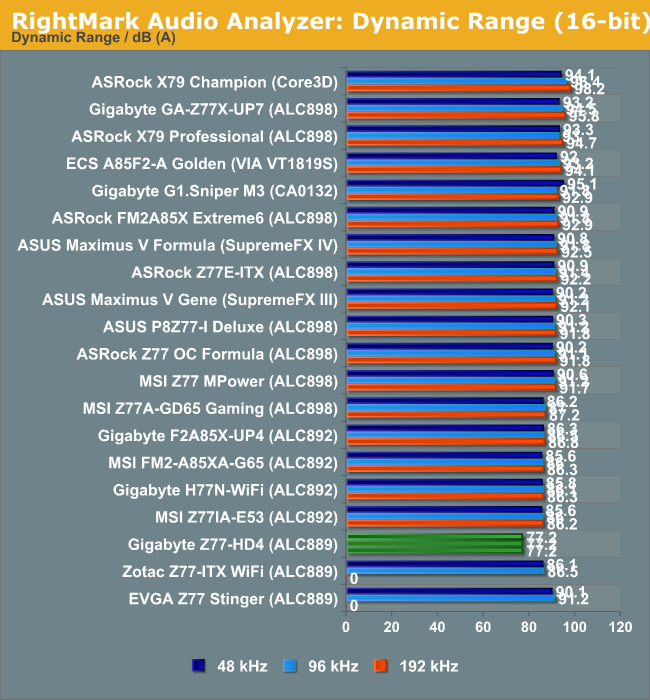
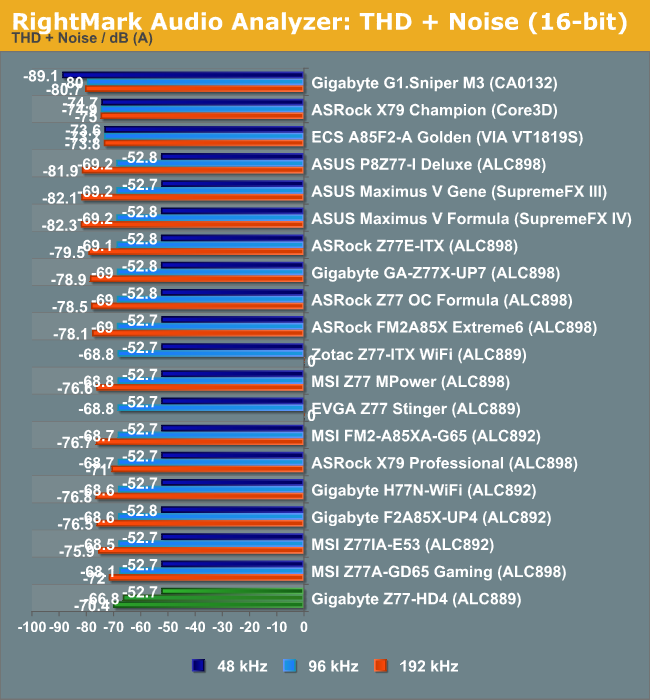
With the price of the board, we get one of the cheaper Realtek audio options. It performs worse in our testing than the ALC89x and above, but is able to pass our 192 kHz test unlike the ALC889 mITX versions.
USB 3.0 Backup
For this benchmark, we run CrystalDiskMark to determine the ideal sequential read and write speeds for the USB port using our 240 GB OCZ Vertex3 SSD with a SATA 6 Gbps to USB 3.0 converter. Then we transfer a set size of files from the SSD to the USB drive using DiskBench, which monitors the time taken to transfer. The files transferred are a 1.52 GB set of 2867 files across 320 folders – 95% of these files are small typical website files, and the rest (90% of the size) are the videos used in the WinRAR test.
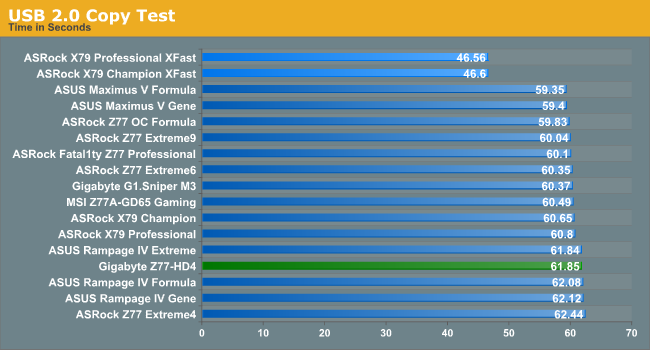
USB 2.0 performance is middling, on the wrong side of 61 seconds but only a fraction worse than the top non-XFast score.
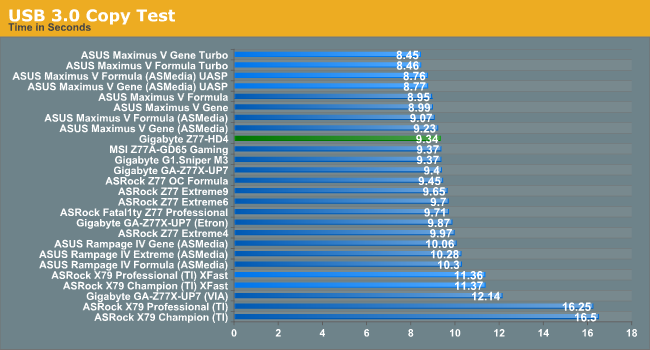
By contrast, the USB 3.0 performance is nearer the sharp end, despite sequential write speeds not being the best.
DPC Latency
Deferred Procedure Call latency is a way in which Windows handles interrupt servicing. In order to wait for a processor to acknowledge the request, the system will queue all interrupt requests by priority. Critical interrupts will be handled as soon as possible, whereas lesser priority requests, such as audio, will be further down the line. So if the audio device requires data, it will have to wait until the request is processed before the buffer is filled. If the device drivers of higher priority components in a system are poorly implemented, this can cause delays in request scheduling and process time, resulting in an empty audio buffer – this leads to characteristic audible pauses, pops and clicks. Having a bigger buffer and correctly implemented system drivers obviously helps in this regard. The DPC latency checker measures how much time is processing DPCs from driver invocation – the lower the value will result in better audio transfer at smaller buffer sizes. Results are measured in microseconds and taken as the peak latency while cycling through a series of short HD videos - under 500 microseconds usually gets the green light, but the lower the better.
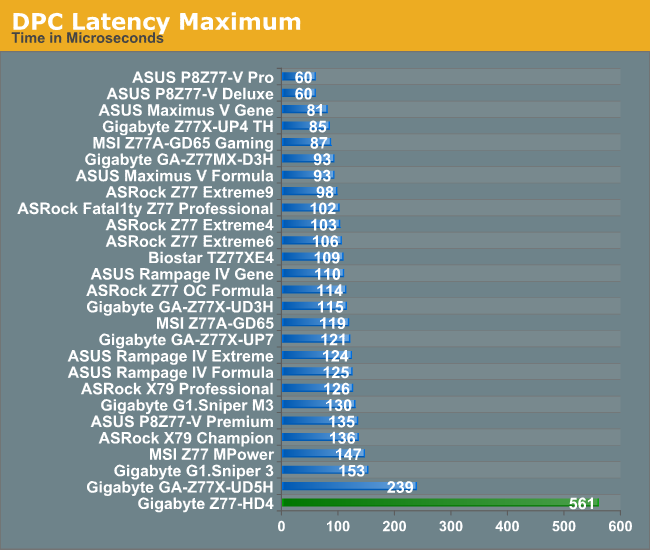
A major realisation of having that un-optimised BIOS is perhaps shown best in the DPC. To start, with the default install, the monitoring features of ET6 causes the DPC to peak at over 800 microseconds. Disabling this software causes a maximum of around 114 microseconds, although every so often we encountered a peak of around 300-500 microseconds, and 561 was recorded as the highest peak.










63 Comments
View All Comments
lever_age - Sunday, May 19, 2013 - link
I also agree that a greater emphasis should be placed on these cheaper options. It's not always easy to be able to tell when too many corners have been cut.Particularly with power consumption going down the way it has, all the companies are rather overselling VRMs for overclocking. For a moderate 24/7 overclock on air, enough to satisfy say a gamer wanting to grind something out of the SC2 engine or somebody wanting to speed up some calculations, where's the cutoff point of quality in how low you can reasonably go? (Yeah, more phases and higher switching frequency can mean lower ripple, and lower temps and power losses are better, but how much of a big difference does that really make?) Of course, it's still hard to tell about longevity.
klmccaughey - Sunday, May 19, 2013 - link
Been using Gigabyte boards for ten years now almost exclusively. They're always good with decent overclock options. Never had a bad one yet.Wall Street - Sunday, May 19, 2013 - link
I feel like Ian is stretching when he critiques this board for not having onboard power/reset buttons and error code displays. I guess he assembles and disassembles systems all day long, but having these features on my current motherboard, I never use them (I only have them because I needed to replace my 1156 board and only high-end parts are still readily available when I ordered).I guess he has finally seen the light when it comes to overclocking though. The motherboard makers stretch as much as they can to justify the extra $50=$100 to up-sell enthusiasts. However, Intel has done an incredible job designing their chipsets and most users don't need 8+ SATA, 12+ power phases, or debug codes, and few use SLI/Crossfire.
Wall Street - Sunday, May 19, 2013 - link
And I forgot to mention "this board is probably aimed at the internet café market in China" is pretty shameful and below the belt Ian. As you have shown yourself, it is just as good at gaming as the $200+ boards unless extreme overclocking or multi-GPU. Go look at a Steam survey to see what actual gamers have installed - this board is quite capable of power a system in the top 1% of Steam users.A5 - Sunday, May 19, 2013 - link
Seriously. There are so few use cases that justify the $200+ boards.I know the $300 boards are more fun to review, but I think AT users are better served with reviews of these sub-$150 Z-series boards.
ForstAmt - Sunday, May 19, 2013 - link
What those guy said.I honestly don't know what the point of this review is. So having a HE GPU running in a PCIe x4 slot is not a good idea. Really? Well I don't think that in 2013 anyone needed a review to know that. Seems like that is the main focus of the review though.
For most people running PCs on hardware aimed at chinese internet cafes it would probably be much more interesting how well thought trough the layout is.
Are the fan connectors positioned in a way that makes sense? How about the slot layout: Can you use a graphics card (2 or 3slot) along with 2 or 3 other pci and/or pcie cards without problems? (and no, i am not talking about another gpu -.-).
But atleast the reviewer was honest at the beginning when he stated that he doesn't have a clue. And it shows. I really like anandtech but this review aggravated me enough to register and comment.
p.s.: I hope my chinese internet cafe hardware manages to send this comment in a way that makes it readable on you guys using the regular sniperelite and rog gaming elite stuff.
ForstAmt - Sunday, May 19, 2013 - link
Please excuse the typos.kmmatney - Sunday, May 19, 2013 - link
Well - the review was useful for me. These are the types of boards I buy, and I might have missed the fact that it uses a 4x slot for the second card. I effectively spent $59 for my My GA-Z77X-UD3H, but didn't think to look at what happens when you run 2 GPUs. Thankfully my board runs them at 8x/8x, which gives better performance, but I hadn't thought to even check that when I bought it. Not that I've ever used 2 GPUs...jonjonjonj - Wednesday, May 22, 2013 - link
why the techpowerup article only shows a 5% difference between 3.0 x16 and 2.0 x4 with a 7970. terrible crossfire drivers?http://www.techpowerup.com/reviews/Intel/Ivy_Bridg...
Jambe - Sunday, May 19, 2013 - link
I agree but I'd also like to see reviews of boards with other chipsets, namely Z75 and H77.